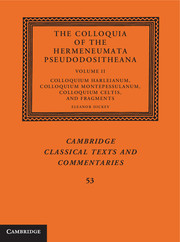Book contents
- Frontmatter
- Dedication
- Content
- List of plates page
- List of figures
- Acknowledgments
- Part One Colloquium Harleianum
- 1 Introduction to the Colloquium Harleianum
- TEXT, TRANSLATION, AND CRITICAL APPARATUS
- 2 Index Siglorum
- 3 Colloquium Harleianum
- Commentary
- 4 Commentary
- Part Two Colloquium Montepessulanum
- 5 Introduction to the Colloquium Montepessulanum
- Text, Translation, and Critical Apparatus
- 6 Index Siglorum
- 7 Colloquium Montepessulanum
- Commentary
- 8 Commentary
- Part Three Colloquium Celtis
- 9 Introduction to the Colloquium Celtis
- Text, Translation, and Critical Apparatus
- 10 Index Siglorum
- 11 Colloquium Celtis
- Commentary
- 12 Commentary
- Part Four Related texts
- 13 Editions of Papyri Connected to the Colloquium Tradition
- 14 The Berlin Trilingual Papyrus (P.Berol. INV. 10582): Reprinted Edition
- 15 Assorted Conversational Fragments(P.Berol. INV. 21860): New Edition
- 16 A Glossary Including Conversational Phrases (P.Lond. II.481): New Edition
- 17 A Glossary of Homonyms with Grammatical Information (P.Sorb. INV. 2069 Verso): Reprinted Edition
- 18 Grammatical Paradigms for Latin Learners (P.Louvre INV. E 7332): Reprinted Edition
- Endmatter
- References
- Indices to volumes I and II
- Index of notable Greek words and phrases
- Index of notable Latin words and phrases
- Index of topics mentioned in the colloquia
- Index of subjects discussed in the introduction and commentary
14 - The Berlin Trilingual Papyrus (P.Berol. INV. 10582): Reprinted Edition
Published online by Cambridge University Press: 25 November 2020
- Frontmatter
- Dedication
- Content
- List of plates page
- List of figures
- Acknowledgments
- Part One Colloquium Harleianum
- 1 Introduction to the Colloquium Harleianum
- TEXT, TRANSLATION, AND CRITICAL APPARATUS
- 2 Index Siglorum
- 3 Colloquium Harleianum
- Commentary
- 4 Commentary
- Part Two Colloquium Montepessulanum
- 5 Introduction to the Colloquium Montepessulanum
- Text, Translation, and Critical Apparatus
- 6 Index Siglorum
- 7 Colloquium Montepessulanum
- Commentary
- 8 Commentary
- Part Three Colloquium Celtis
- 9 Introduction to the Colloquium Celtis
- Text, Translation, and Critical Apparatus
- 10 Index Siglorum
- 11 Colloquium Celtis
- Commentary
- 12 Commentary
- Part Four Related texts
- 13 Editions of Papyri Connected to the Colloquium Tradition
- 14 The Berlin Trilingual Papyrus (P.Berol. INV. 10582): Reprinted Edition
- 15 Assorted Conversational Fragments(P.Berol. INV. 21860): New Edition
- 16 A Glossary Including Conversational Phrases (P.Lond. II.481): New Edition
- 17 A Glossary of Homonyms with Grammatical Information (P.Sorb. INV. 2069 Verso): Reprinted Edition
- 18 Grammatical Paradigms for Latin Learners (P.Louvre INV. E 7332): Reprinted Edition
- Endmatter
- References
- Indices to volumes I and II
- Index of notable Greek words and phrases
- Index of notable Latin words and phrases
- Index of topics mentioned in the colloquia
- Index of subjects discussed in the introduction and commentary
Summary
This papyrus (for which see also section 2.1.3 above) provides a fragment of a seventh colloquium, distinctly different from the six that survive via the medieval manuscript tradition. It is more closely related to the colloquium Montepessulanum than to the other five complete colloquia, but even there the relationship is not especially close. In the papyrus this colloquium is trilingual, including a Coptic translation as well as Latin and Greek, but since it is clearly related to the bilingual colloquia, and since the Coptic is evidently a translation of the Greek made at a stage when transmission errors had already occurred, the colloquium must originally have been bilingual. Presumably the bilingual text was adapted by the addition of the third language; the Latin has also been transliterated into Greek script, so the intended audience was presumably interested in oral Latin rather than reading skills. The Coptic is of poor quality, because the original adaptor was not fluent in Coptic and/or because the text was subsequently transmitted by scribes not fluent in Coptic, and there are many uncertainties about the readings in that portion of the text. Here only the Latin and Greek, which can be more securely read and are directly relevant to the colloquium tradition, are presented.
The papyrus dates to the fifth or sixth century and has been edited by Schubart (1913), Kramer (1983: no. 15 (with good commentary), 2010), and Dickey (forthcoming a); Cavenaile (1958: no. 281) reprints Schubart's edition, and Hasitzka (1990: no. 270) reprints Kramer's first edition. The text is number 3009 in M–P3and 6075 in LDAB. In the original the columns are not lined up vertically, as is usual in colloquia; rather they are squashed together, and words in the three languages are separated by punctuation (a double point like a modern colon), a feature that seems to derive from the Greek–Coptic glossary tradition (see Dickey forthcoming b). The version presented here, which restores the columnar layout presumably used before the Coptic material was added, is effectively the same as that presented by Dickey (forthcoming a), where further discussion and a separate diplomatic transcript in the original layout can also be found. Here the line divisions are original, but some of the word divisions and all the punctuation, capitalization, and diacritics are editorial.
- Type
- Chapter
- Information
- The Colloquia of the Hermeneumata Pseudodositheana , pp. 270 - 279Publisher: Cambridge University PressPrint publication year: 2015



